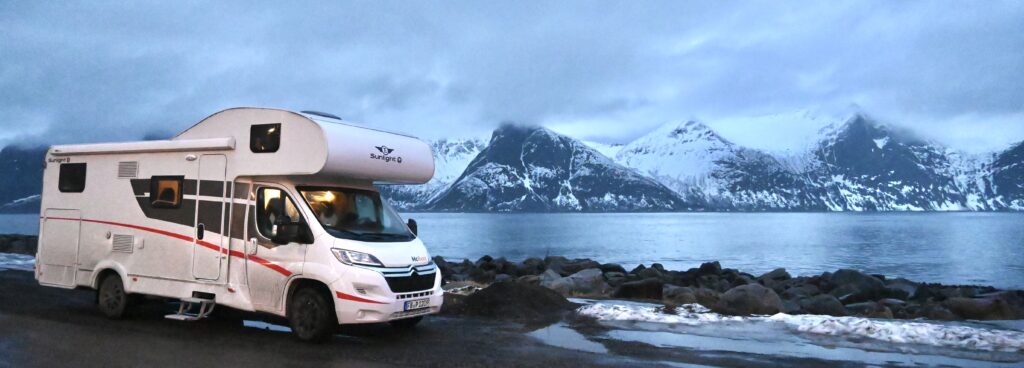
For the past 4 weeks we have been driving a “Family Luxury” campervan through Norway in winter. ‘Crazy’ I hear you shout, perhaps, but there are always two sides to every coin, even the Norwegian Krone. Our reason for being here at this time of year is to view the northern lights (Aurora borealis) and in that regard we have been spectacularly successful!!
There are other upsides to winter travel. The roads are quieter and no one seems in too much of a hurry. Freedom camps are empty and I’m guessing the locals are cutting us just a wee bit more slack than they would in the height of summer. The app we are using (park4night) often has photos attached to the descriptions and show 20 or more campers awning to awning in each site. We, on the other hand, have had one night where there were two other car-campers about 75 metres away. Some of the suggested camping spots are inaccessible, with the snow ploughed off the road creating an impenetrable barrier between us and a picnic table with views deep into a fjord . Many of the public toilets are closed for the winter and most of the waste dumping stations are either closed or frozen over. Nothing an extra 1⁄2 hour drive can’t overcome by finding a different site.
The roads ranged from 6 lane Autobahn to muddy gravel, and conditions ranged from green fields alongside to just driving between the two edge poles, but generally I could find a good line.
Private ownership of campers seems high in Norway with hundreds of hibernating campers and caravans lurking under tarpaulins in driveways and beside garages across the country. With that comes the infrastructure to support this type of holiday – free waste dumping stations, public bbq sites and fire pits, picnic tables and public facilities are everywhere throughout Scandinavia. Many of the narrower roads have passing bays that double as ‘quick photo opportunity’ bays. Almost everywhere we have camped has come with truly staggering views and some sort of facilities (either open or closed).
Back to the “Family Luxury” – we decided on a campervan larger than we needed. It’s almost 8 metres long and sleeps 6 (I wouldn’t want to be number 5 or 6!). What this means for us in winter is more storage space, more living space, a bigger heating unit, larger water capacity and the kids have their own “bedroom”, which doubles as a play space, library, wardrobe and adventure park. The best bit is that it doesn’t need to be packed away each morning. When we stop for an hour they can escape to their room for some time away from Mum and Dad.

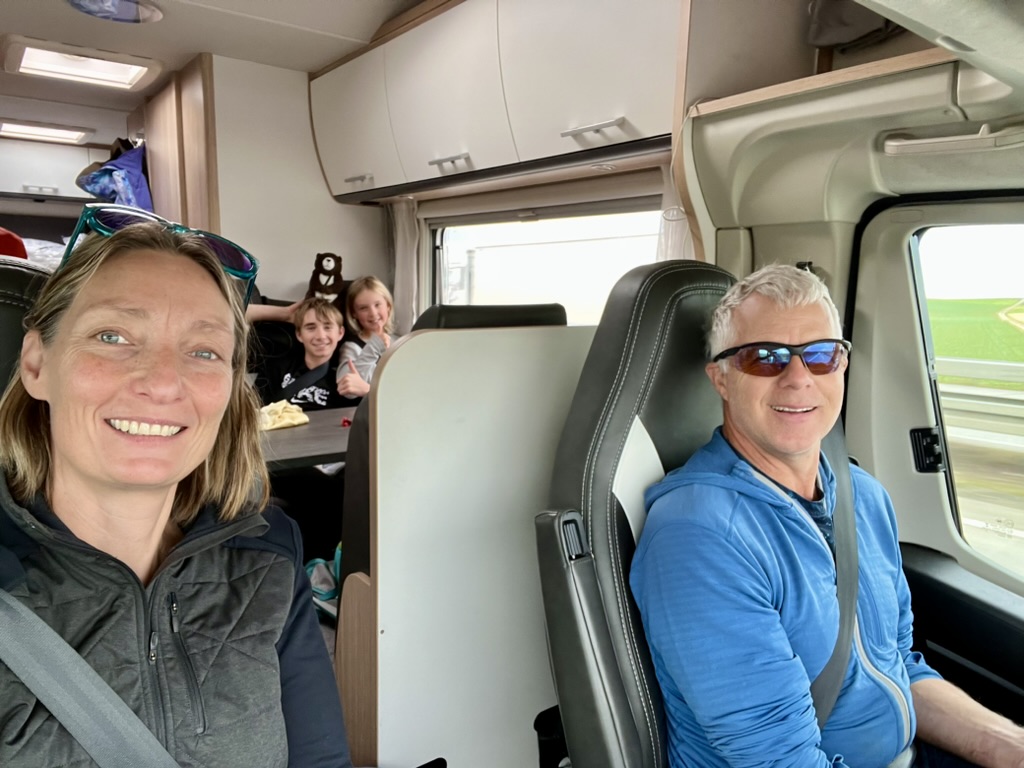
Hired in Germany, the camper was ‘winterised’ for us. It turns out that German winterisation runs only as far as winter tyres and antifreeze in the washer unit. There was certainly little in the way of real winter-readiness for our journey. Not long after leaving Germany we stopped to buy a set of chains as the tyres are not studded like everywhere else in Europe – the roads are managed by allowing a layer of ice and compacted snow to form across the road surface allowing the metal studded tyres to bite. A few of the roads, corners and particularly hills that we tackled were overcome through keeping my boot in and driving through the weaving back end.
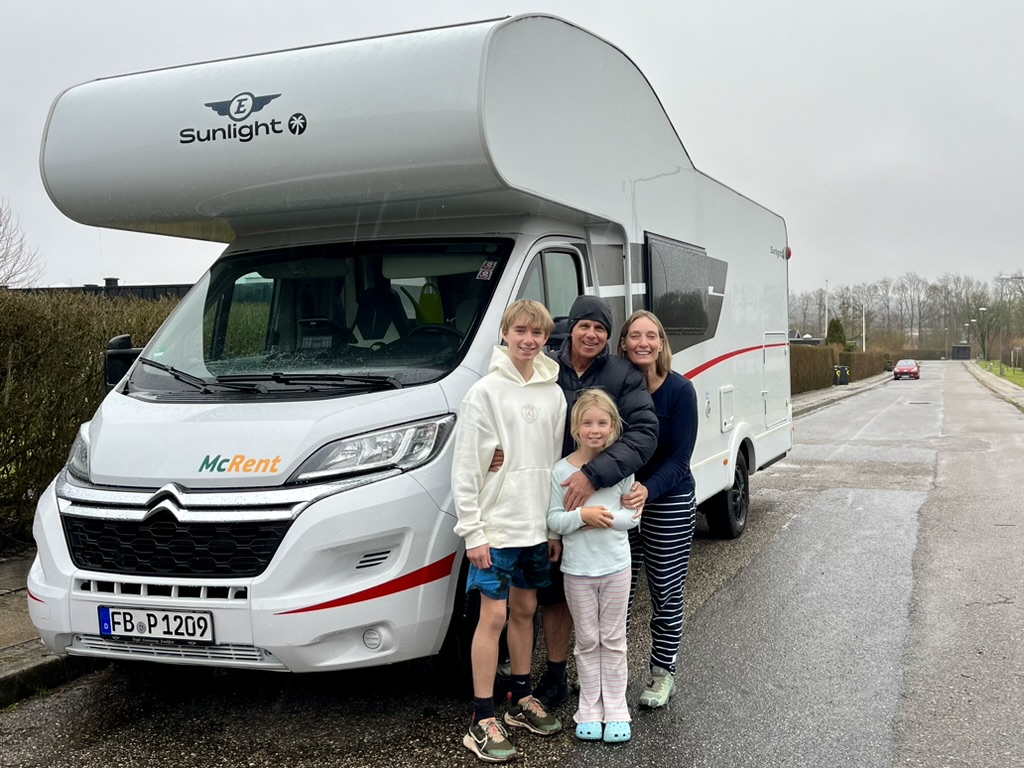
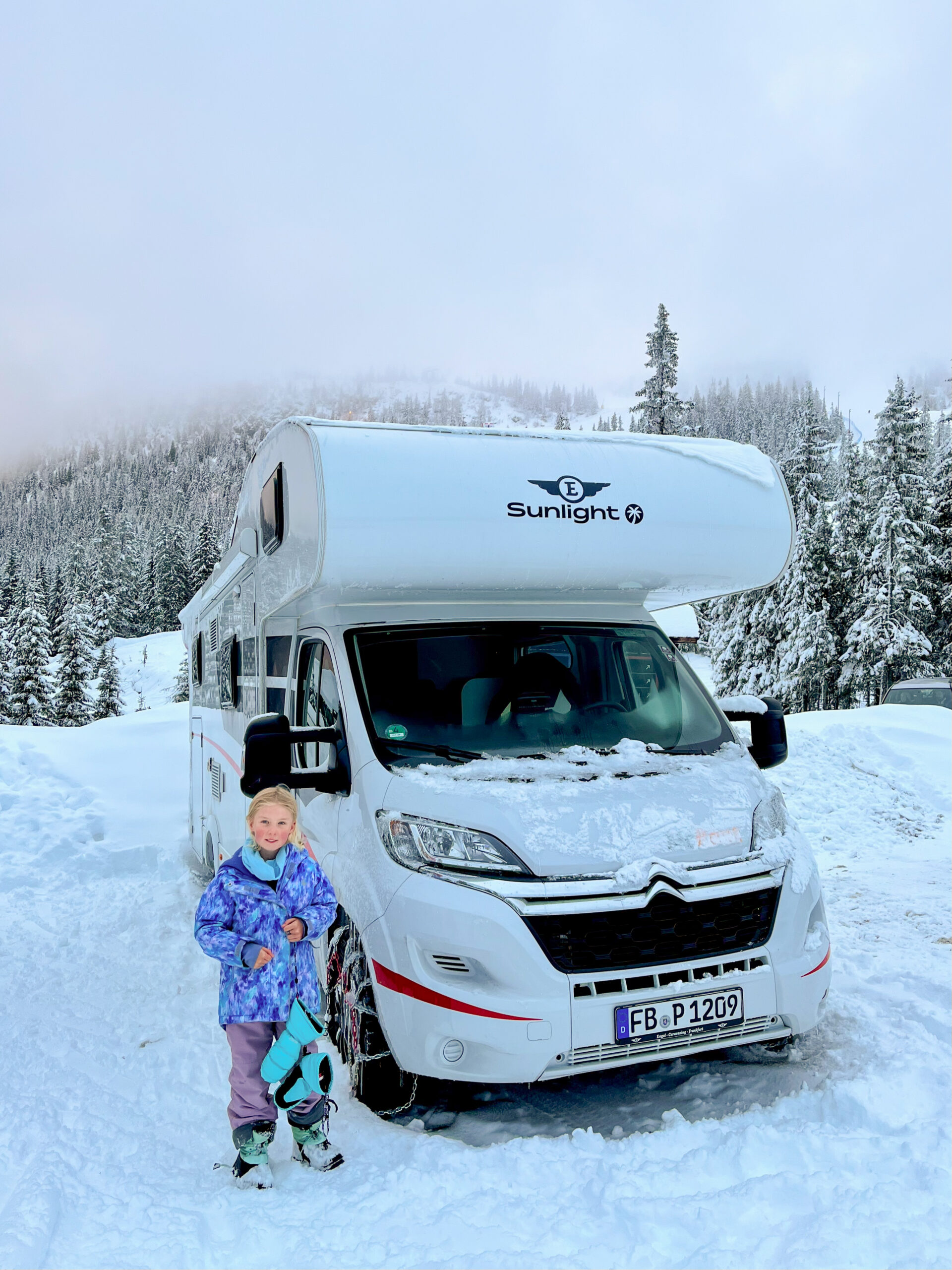
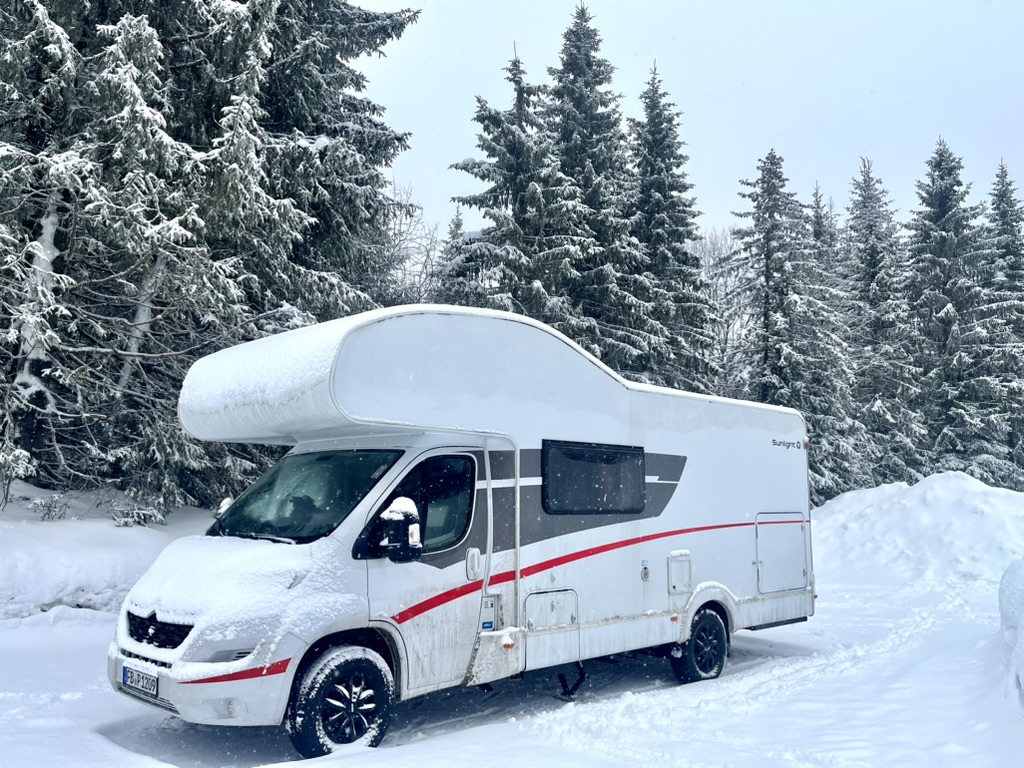
Because of the size of the camper and the wintery conditions, Keryn has decided not to drive this leg of the adventure (but is looking forward to getting behind the wheel of our Land Cruiser in Africa), so all of the steering has been up to me. Somehow that comes with toilet emptying and grey-water management, gas bottle swapping (at 3am), unfreezing blocked pipes and filling the onboard water. Thankfully everyone is great at taking advantage of roadside pit stops. We have also had the secret weapon of Fire Stations throughout our host country. All have been helpful and welcoming.
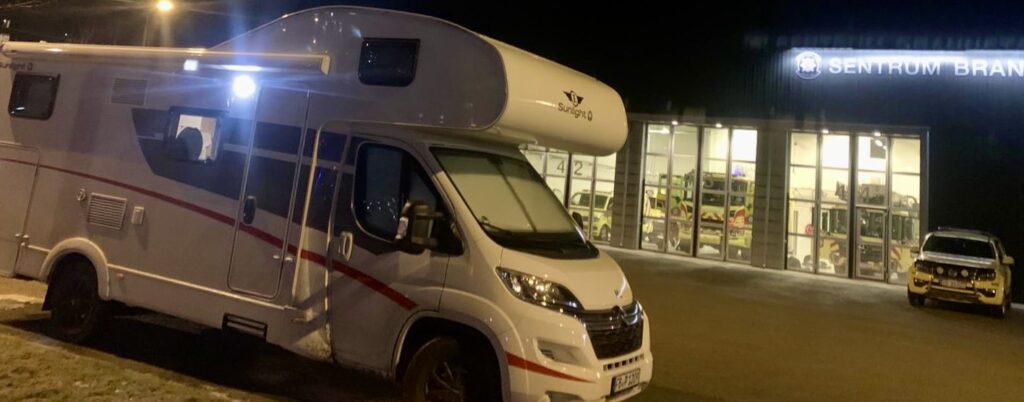
Some of the roads have been pretty treacherous and take long periods of concentration – it can be exhausting and you don’t get to see much other than a few hundred metres of road directly in front of you. But as the driver you also get rewarded by being able to stop whenever you want, you get to drive the hundreds of tunnels that litter the countryside like fallen leaves, and enjoy the joy of driving when the snow clears and the road opens out in front of you, a black ribbon winding its way through the valleys.
Tunnellen – Somewhere in the back of my head I knew there was some association between Norway and trolls – but wow! It turns out that Norweigiens are just as happy below ground as they are above. Someone obviously did a deal on tunnelling machines, buy one get 37 free. It seems whoever sold the drilling machines to Norway taught the contractors how to switch them on and steer them, but it seems the last few pages of the user manual – the part about how to switch them off – were missing, so the machines just ran, slowly chewing their way through every lump in Norway. I’m guessing they all just fell into the North Sea at some point or are still working their way through the Russian countryside.
There are tunnels, thousands of metres long, serving communities of 20 houses. From an engineering standpoint – every hole is a magnificent work of art. Norway has over 1200 road tunnels – most because the tight valleys or deep fjords do not lend themselves to surface roads, but some, it seems, are just for fun. The Spiralen is a 1.6 kilometre corkscrew up through the inside of a mountain that started because they needed some gravel for a local road, then just kept digging up and around and around and around.

The vision was grand, and the end result amazing but the Club Room, the Youth Club, Exibition Hall, Bowling Alley, Theatre, the Open Air Theatre and the multi-story Restaurant and lookout building never eventuated.
Tunnels on the road network range from a few hundred metres to the world’s longest road tunnel at 24.5 kilometres in length. They twist and turn, they drop below the frigid waters of the Norwegian sea or under the city centre. Some have subterranean on and off ramps and a couple included a roundabout where several tunnels intersected somewhere within the trolls’ domain. The efficiency of tunnels is amazing – once built they have a long life, are weather resistant and collectively save millions of hours of driving in Norway. The downside for a driver is losing your sense of direction as you weave your way through an unknown number of compass points underground. You emerge with the sun over your opposite shoulder and no idea which way you have emerged.
Not to be outdone by the trolls, the fairies have put some effort into the bridges. I don’t remember crossing a single straight-forward bridge. Each span, a thing of beauty, arching up into the clouds, sweeping through majestic curves or climbing through unnatural angles.
The bridges connect islands, cross chasms and leap waterways like they were free to build and every engineer was trying to outdo the last.
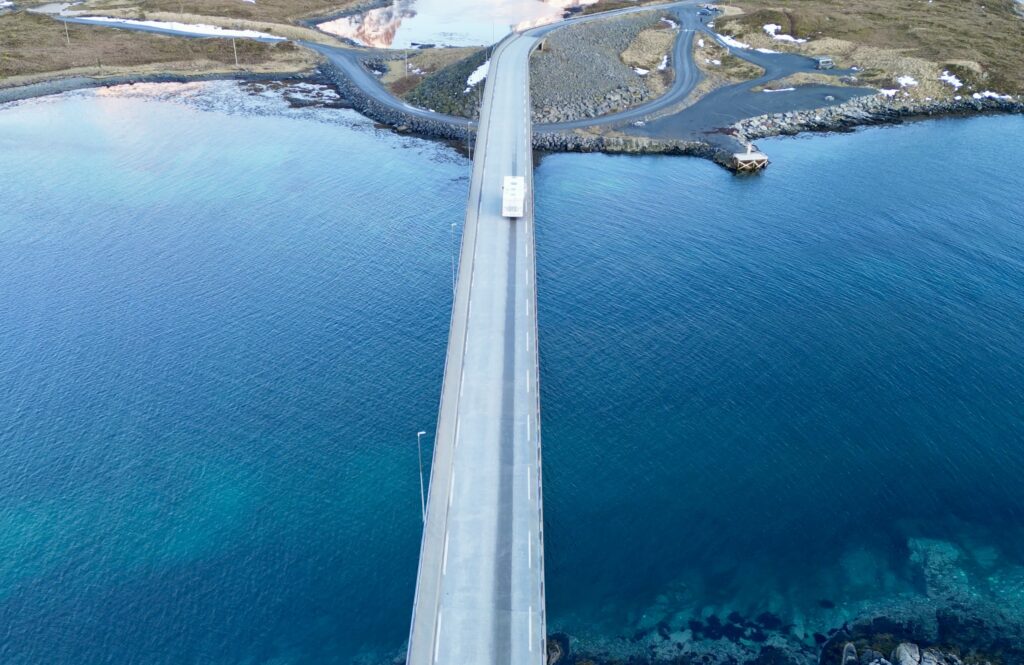
The driving itself is pretty straightforward. There are only 973 different pictograms to decipher as you drive. They are very intuitive, such as this one:
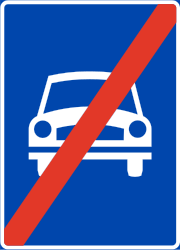
Which means carry on driving normally.
Or this one:
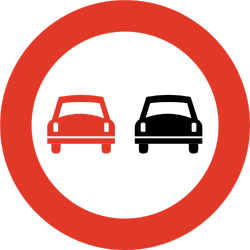
Which I think means “if you are driving a red Citroen ID you can overtake”
This sign means do NOT drive on to the ferry if the ferry is not there:

and I’m guessing this means your car may get tired and need a sleep:
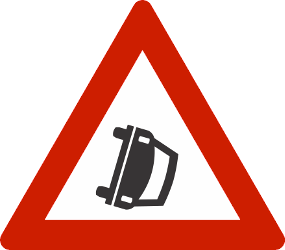
They also believe it is important to distinguish which large animal you are likely to collide with using the following signs:
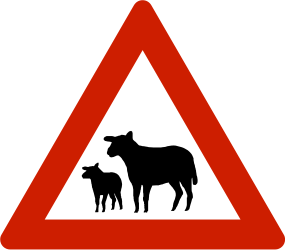

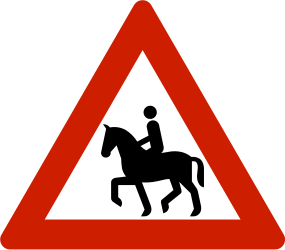

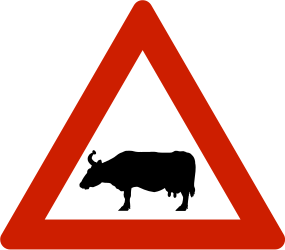
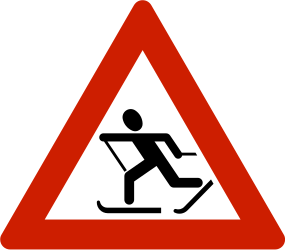
While most people drive on the right hand side of the road, you don’t have to if you are a very large truck driving fast – then you can just sit on the centre line and watch everyone get out of the way. Trying to be a considerate campervan driver, I was frequently pulling over to let others pass. Out of the major towns there are plenty of opportunities to nip into a passing bay, or simply indicate and slow until trailing cars pass.
We had a very loose rule not to drive at night above the arctic circle – but some of the best driving was on the quiet roads in the evening. I tried hard to stop when the outside temperature dropped below -10 C and the normally treacherous roads become underivable in the camper.
Other than oil, washer fluid, AdBlue and lots of diesel, the camper has been pretty straight forward, which is lucky as the rental company offered no training or advice. When a door handle did break they suggested taking the camper to their dealer support network 1500 km in the wrong direction. Thankfully I had my multitool and the spring from a clothes peg to MacGyver a fix.
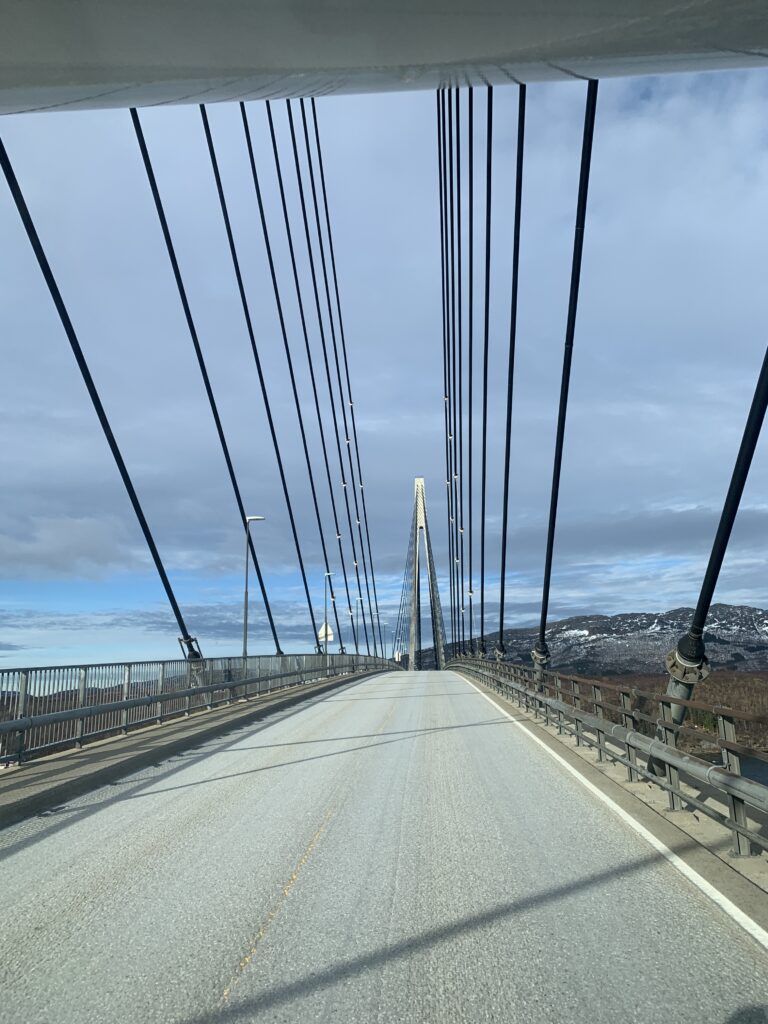
The average car in New Zealand travels around 10,000 km in a year. By the time we drop off the camper we will have driven more than 9000 kilometres, crossed under, over and on fjords, driven through mountains and slept in some amazing spaces.
I was looking forward to slowly making our way south and out of the deep snow. It was a gradual change from white to brown and from brown to green. Snow gave way to rain and the heater went from Hi to Low. You don’t realise it at the time, but weeks and weeks of driving a lumbering, hi-sided, front wheel drive drift camper is challenging and draining – hitting the motorway was like a taking a breath on a warm morning.
Hi guys. Your adventures look amazing. It’s a wonderful thing to seize life with your family and you can add this to the bank of memories that you will draw on for the rest of your lives xxx
Fascinating learning about all the tunnels and bridges. Loved the drone footage. What wonderful memories that will be with you all for life. The diving looked very dangerous, makes the snow at Ohakune look like a doodle. Travel safe xx Di
Lots to see!
Could you hold your breath in any of the norway tunnels?